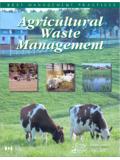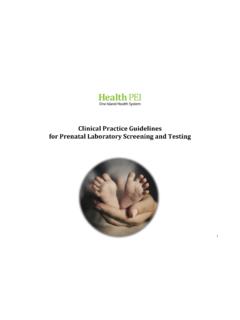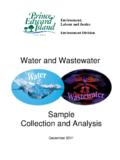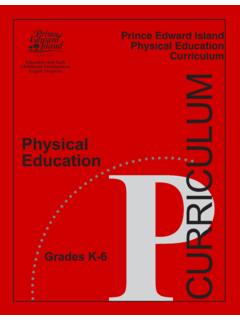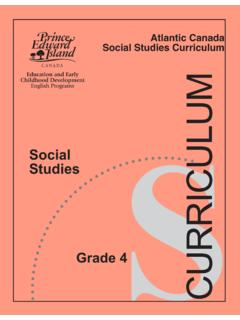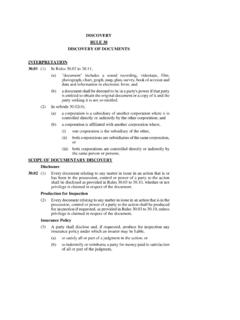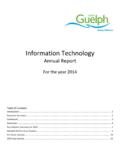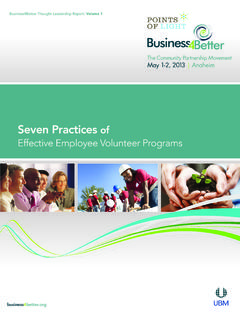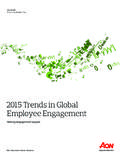Transcription of Employee Assistance Program Evaluation Report
1 Employee Assistance Program Evaluation Report March 2011. i Acknowledgements This Report was prepared by Paul Chaulk, MSc, and Steve McQuaid, MSW, of the Atlantic Evaluation Group, and Dr. Rick Csiernik, Professor of Social Work at the University of Western Ontario (special advisor on best practices in EAP. programs in Canada). The Report preparation was assisted by Jennifer Jones, Atlantic Evaluation Group. The authors wish to acknowledge and thank members of the Employee Assistance Program (EAP) Evaluation Steering Committee (Public Service Commission) for providing direction and support to the Evaluation Team over the course of the Evaluation , including: Aidan Sheridan, Susan MacLeod, Andrew Thompson, and Ed MacAulay. Additional feedback on drafts of the Report and other information was provided by Linda Arsenault and Janet MacDonald of the EAP and Meaghan Zwicker of Finance and Municipal Affairs.
2 In addition, a special note of gratitude is offered to all those who provided their input and comments during the Evaluation data collection process; these include: EAP staff, HR managers, members of the EAP Advisory Committee, union representatives, private counselors, and the many managers and employees from across the PEI public service who responded to the EAP staff survey. ii Executive Summary Introduction The following is the Report of the 2011 Evaluation of the Prince Edward Island Public Service Commission's (PSC). Employee Assistance Program (EAP). The Report outlines the objectives, Evaluation methodology, Evaluation findings and results, and proposed recommendations. The specific objectives of the Evaluation included: x To evaluate the EAP to determine if the current mandate, objectives, services and processes will continue to meet the future needs of the public service. x To evaluate the EAP to determine if the Program is successfully meeting the current Employee and employer requirements, including: Identifying the strengths in processes, service delivery quality and effectiveness in meeting the stated outcome of improved job performance.
3 Identifying the gaps and/or weaknesses in processes, service delivery quality and effectiveness in meeting the stated outcome of improved job performance. x To review and comment on the current EAP Advisory Committee governance model, the EAP. organization structure, and the reporting relationship to the Public Service Commission within the provincial government structure. x To make recommendations for improvement to ensure that the EAP will continue to meet Employee and employer requirements in the future, recognizing fiscal realities as well as the evolving work environment. Evaluation Approach The Atlantic Evaluation Group (AEG) Inc. was contracted to complete the Evaluation . The AEG Evaluation team utilized a mixed methods approach to collect the Evaluation data, including: a comparative best practice literature review; a review of Program utilization data; an extensive survey of employees and managers across the public service system; and a series of qualitative interviews with Program stakeholders, members of the EAP Advisory Committee, EAP Counselors, and employees who had used the Program .
4 Findings and Results Generally speaking, the EAP Evaluation findings from all data collection streams revealed Program and operational strengths on a number of levels. The best practice comparative review noted that in addition to offering services that the majority of Canadian EAPs provide, PEI's Employee Assistance Program demonstrates leadership in four other distinct areas, including: responding to critical incident situations; providing consultation and training for ongoing organizational development and team-building initiatives; enhancing the health of work units through the provision of support such as mediation and conflict-resolution services; and supporting work unit support groups to decrease work-related stress. With respect to the individual confidential counseling service, there was strong positive feedback expressed by all those interviewed and/or surveyed for this part of the EAP Program .
5 The perception among stakeholders interviewed indicated that the counseling service is well utilized, well received, and the sense of satisfaction from those who have used the Program is high. The service was seen as easy to access, and the existing referral protocols seem to be working well. EAP counselors are viewed as professional, well experienced, very dedicated to their work, and providing an important 'add value' service to the public sector. iii Employees who had used EAP services indicated that it was easy to access the Program in terms of knowing where and who to call; that the wait time for the first contact session was very reasonable; and that their level of satisfaction with the service was very high. They indicated that they felt listened to, supported, and helped to develop practical steps to deal with their concerns and issues. In short, the Evaluation data indicates that the existing EAP Program has been well established, is well utilized, and generates high ratings of satisfaction and helpfulness.
6 This provides a strong foundation from which to further strengthen and develop the capacity of the Program . Program Strengths With respect to the strengths of the EAP Program , the Evaluation concluded that: x It is a well established Program with wide acknowledgement and acceptance of its importance and value to both employees and employers. x The PSC is, and has been, highly supportive of the Program ; the governance structure includes involvement and input from all key public sector stakeholders and unions (Advisory Committee). x The EAP counseling staff are highly regarded; viewed as knowledgeable, experienced, and skilled professionals by both users and management at all levels across the public service. x The EAP best practice review identified several areas of strength: The PEI EAP offers all but two services that the majority of Canadian EAPs provide. The PEI EAP demonstrates leadership in four areas not commonly offered by other EAPs: Responding to critical incident situations with trained peer debriefers.
7 Providing consultation and training for ongoing organizational intervention, development and change including team-building initiatives. Enhancing the health of work units through the provision of technical Assistance including mediation or conflict-resolution services on both individual and organizational issues. Development of or Assistance with work unit support groups to decrease work related stress and to act as problem solving and/or peer social support groups A review of PEI EAP policies versus a database of best practices across Canada indicated that PEI's policies scored slightly above average compared to the Canadian best practices. x Surveys revealed a high level of awareness of the EAP Program (86%) and that it offers confidential counseling for employees (84%). x A high proportion (over 90%) of survey respondents using the service indicated some degree of satisfaction with EAP individual counseling.
8 X A high proportion (over 90%) of survey respondents using the service indicated EAP counseling helped deal with the issue and helped them complete their work duties. x Employees interviewed who used EAP individual counseling indicated that the service was a help to them; they felt they were listened to, supported, helped to resolve issues, and helped to become better employees. iv x While the feedback on EAP group sessions was more limited in both interviews and surveys, employees who had attended EAP workplace and wellness sessions were positive regarding the experience. Program Gaps With respect to EAP Program gaps and areas to address and strengthen, the Evaluation concluded that: x While overall EAP awareness was high (as noted above), Program profile and visibility across the broad public sector is still lower than ideal in some subgroups such as newer employees and for specific aspects of the Program such as availability for family members.
9 X There are some perceived concerns by a small minority of non-users of individual counseling surveyed regarding confidentiality and potential impact on job promotions. x There is no defined strategy, and limited financial support for, the ongoing professional development needs of EAP counselors. x There is insufficient focus on some aspects of management of the Program due to pressures of individual counseling demand; , promotion of Program . x There are not enough EAP staff resources to address worksite education, early intervention, prevention and wellness promotion to the extent desired. x There is a lack of after hours counseling service and support (at the time of Evaluation ). x While the current governance model, organizational structure and reporting relationship were generally viewed to be adequate, it was felt that the Advisory Committee might be strengthened and union representation and engagement could be stronger.
10 Proposed Recommendations A condensed list of proposed steps to improve and strengthen the EAP Program include (see Section for full list): 1. Update and further strengthen written EAP policies in reference to the detailed best practice information available from this Evaluation . 2. Strengthen and target ongoing promotion of EAP individual counseling services. 3. Further explore best practices as to how to manage the small proportion of EAP cases which are formal referrals to EAP counseling. 4. Collaborate with HR managers to develop a strategy to improve workplace wellness and quality of worklife, within the limits of available resources. 5. Strengthen ongoing professional development for EAP Manager and counseling staff. 6. Strengthen Program management through development of a workplan/strategy, to be presented and discussed with the Advisory Committee on an annual basis, addressing issues raised by this Evaluation and other emerging issues.
